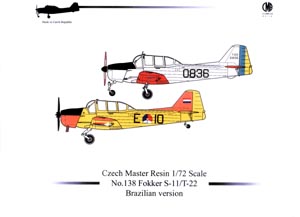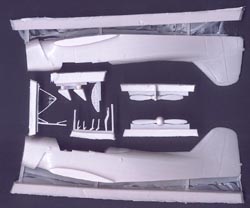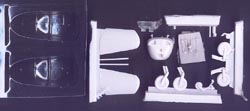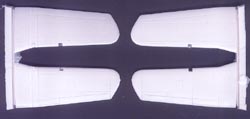Czech Master Resin 1/72 Fokker S.11/S.12/T-22
|
 |
Overview
When this kit came across my desk, I went out on the web and did some
searching to see what I could find out about it, as I had nothing in my
references. I found very little in the way of background, though. Basically
it was a replacement for the Tiger Moth in Dutch service, and it also
served with Israel, Italy, and Brazil. The S.12 was a Brazilian development
that incorporated a nose wheel. For the S.11, the Netherlands bought 40,
Israel 41, Macchi license-built 150 as the MB 416, and Brazil built 100.
For the S.12/T-22, 50 were built in Brazil.
Type: S.11
Country: The Netherlands
Function: trainer
Year: 1950 Crew: 2 Engines: 1 190hp Lycoming O-435
Wing Span: 11.00m Length: 8.15m Height: 2.40m Wing Area: 18.50m sq.
Empty Weight: 810kg Max.Weight: 1100kg
Speed: 215km/h Ceiling: 4000m Range: 695km
 The
Kit The
Kit
This latest release from Czech Master Resin continues their line of
quality resin kits, with good detailing and simple construction. The kit
comes packaged in a Ziploc bag, with all the resin parts sealed in plastic
inside. Two vacuformed canopies are also included, as is a nice decal
sheet with several options provided. The parts are crisply cast, with
finely recessed panel lines throughout. Optional parts for the different
variants are included, with two styles of propellers, two styles of main
gear, and a separate nose wheel strut provided.
 Looking
at the interior, this kit has a fairly simple arrangement. A single-piece
floor includes the control sticks and throttle quadrants molded in place.
Normally this would result in breakage, but CMR packaged this piece inside
one of the canopies, so it is well protected. Onto this fits a pair of
simple seats, with some bracing behind them provided separately. An instrument
panel and some sidewall detailing finish up the interior. Looking
at the interior, this kit has a fairly simple arrangement. A single-piece
floor includes the control sticks and throttle quadrants molded in place.
Normally this would result in breakage, but CMR packaged this piece inside
one of the canopies, so it is well protected. Onto this fits a pair of
simple seats, with some bracing behind them provided separately. An instrument
panel and some sidewall detailing finish up the interior.
 Once
the interior is finished, construction is straightforward and should go
quickly. The fuselage is split in two halves, with a separate nose section.
The wings and tailplanes are separate, and molded as solid right and left
pieces. There are two choices for the wings, depending on the version
you choose, so decide early on which option you'll take. The landing gear
pieces are all molded with the strut and wheel together, which will take
some careful painting, but results in a stronger undercarriage. Once
the interior is finished, construction is straightforward and should go
quickly. The fuselage is split in two halves, with a separate nose section.
The wings and tailplanes are separate, and molded as solid right and left
pieces. There are two choices for the wings, depending on the version
you choose, so decide early on which option you'll take. The landing gear
pieces are all molded with the strut and wheel together, which will take
some careful painting, but results in a stronger undercarriage.
 The
decal sheet, while small, is very impressive, as it includes markings
for five different aircraft. There are two Dutch examples, a pair of Israeli
examples, and one Brazilian. The first Dutch example, a S.11 from No.
5 Instruction Squadron, coded E-17, is finished in overall silver, with
dayglo orange panels on the wings, nose, and tailplanes. The second Dutch
option, from No. 9 Instruction Squadron, coded E-10, is similarly finished,
replacing the silver with trainer yellow. Both Israeli examples are finished
in overall yellow, one with a red rudder and the other with a black fuselage
top and wingtips. The Brazilian example is probably the most colorful,
with a silver fuselage, black anti-glare panel, white upper decking and
fin, and international orange wings and stabilizers. All of the decals
are well printed by MPD and should have no problems in application. The
decal sheet, while small, is very impressive, as it includes markings
for five different aircraft. There are two Dutch examples, a pair of Israeli
examples, and one Brazilian. The first Dutch example, a S.11 from No.
5 Instruction Squadron, coded E-17, is finished in overall silver, with
dayglo orange panels on the wings, nose, and tailplanes. The second Dutch
option, from No. 9 Instruction Squadron, coded E-10, is similarly finished,
replacing the silver with trainer yellow. Both Israeli examples are finished
in overall yellow, one with a red rudder and the other with a black fuselage
top and wingtips. The Brazilian example is probably the most colorful,
with a silver fuselage, black anti-glare panel, white upper decking and
fin, and international orange wings and stabilizers. All of the decals
are well printed by MPD and should have no problems in application.
Conclusion
This is an interesting little aircraft, with several colorful marking
options, and its simple construction should pose no problem even for modelers
new to full-resin kits. The biggest challenge will be in figuring out
which country's markings to build it up in.
|
|
